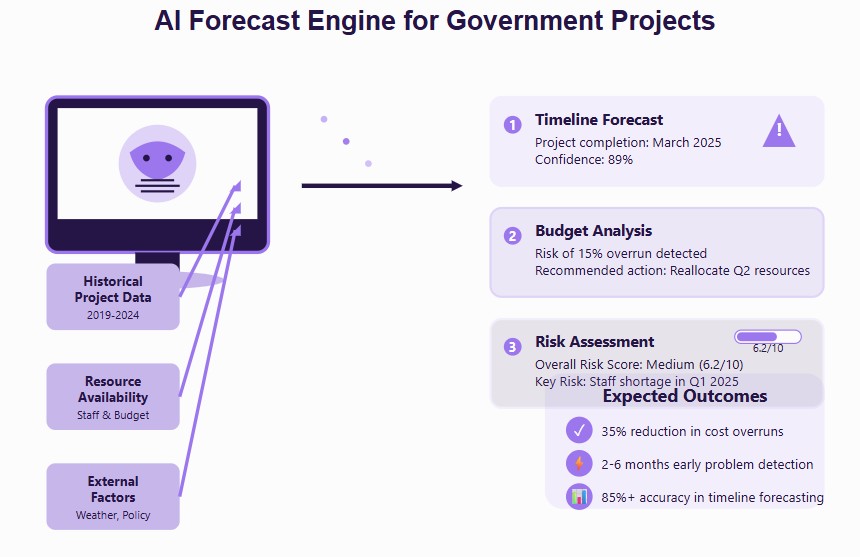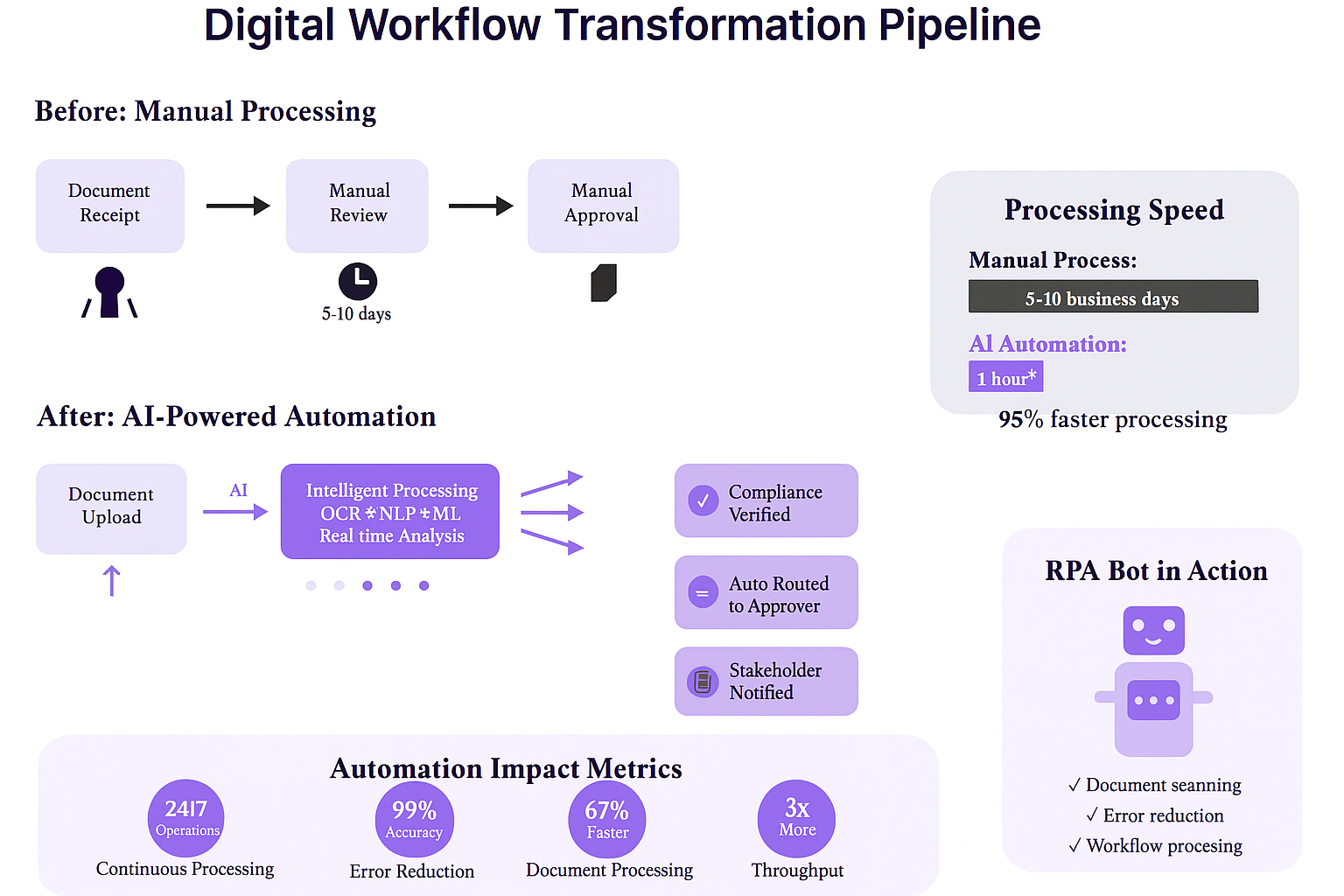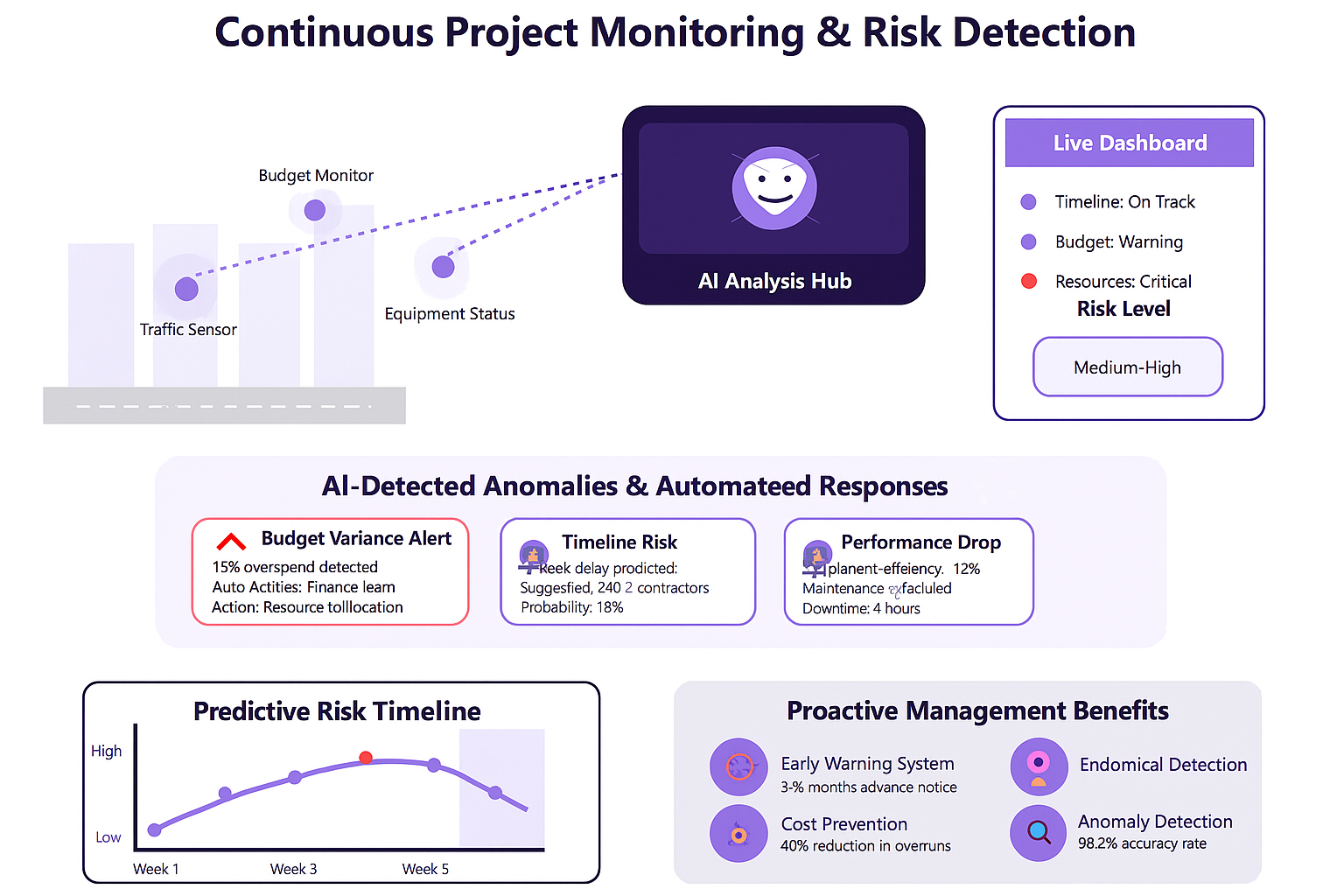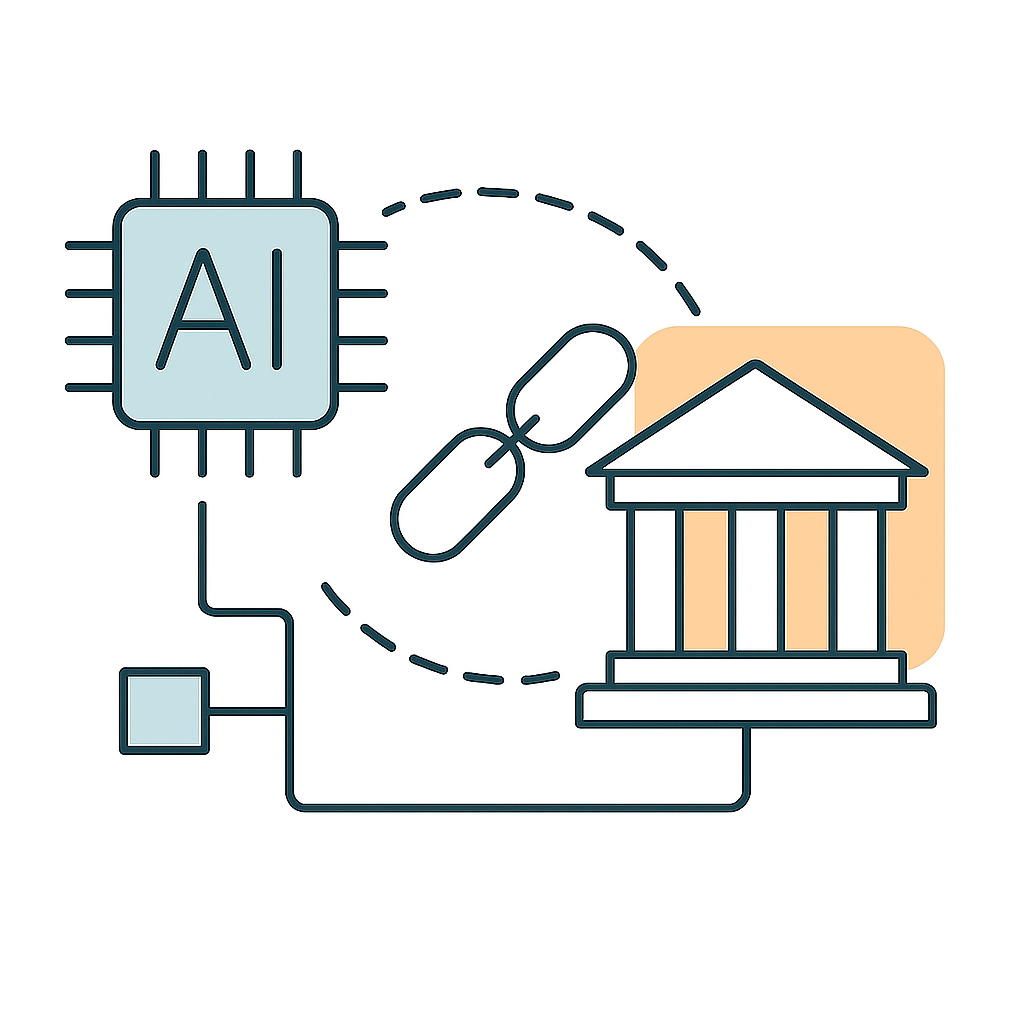Despite decades-old infrastructure, government agencies are making major strides by adopting AI where it matters most. How AI is enhancing project management in government initiatives lies in its power to uncover patterns, predict risks, and optimize decisions at a scale legacy systems could never reach - delivering faster, more accountable results for the public.
In this article, we will:
- Discover how AI transforms project delivery across government sectors
- Integrate AI into legacy systems without disrupting critical operations
5 Game-Changing Ways AI is Revolutionizing Government Project Management
Government agencies worldwide are experiencing a transformational shift in how they manage complex projects, thanks to artificial intelligence. From preventing costly delays to optimizing resource allocation, AI is delivering measurable results that are reshaping public sector efficiency.
Here's exactly how AI is enhancing project management in government initiatives across the globe.
1. Predictive Analytics for Smarter Planning
AI models are transforming government project planning by analyzing vast datasets to forecast potential bottlenecks before they occur. These sophisticated algorithms examine historical project data, resource availability, and external factors to provide early warning systems that prevent disasters.
Key Capabilities:
- Timeline forecasting - Predict project delays 2-6 months in advance with 85 %+ accuracy
- Budget variance detection - Identify potential cost overruns before they materialize
- Resource bottleneck identification - Flag staffing and equipment shortages early
- Risk scoring algorithms - Provide quantified risk assessments for decision-makers
Real-World Example: The U.S. Department of Transportation's Advanced Research Projects Agency-Infrastructure (ARPA-I) has launched a $15 million Complete Streets AI Initiative specifically designed to leverage artificial intelligence and machine learning for transportation infrastructure decision-making. This program uses AI to bridge existing data gaps and create interactive visualizations that help state and local governments make informed infrastructure decisions.
The predictive capabilities enable project managers to adjust timelines and resources proactively rather than reactively responding to problems, resulting in significant cost savings and improved project success rates.

2. Automated Workflows to Reduce Bureaucratic Delays
Government agencies are deploying Robotic Process Automation (RPA) combined with AI to eliminate the manual bottlenecks that traditionally slow down government projects. This technology streamlines document processing, compliance checks, and approval workflows with remarkable efficiency.
Process Automation Areas:
- Document processing - OCR and NLP extract key information from contracts and permits
- Compliance verification - Automated cross-referencing against regulatory frameworks
- Approval workflows - Dynamic routing based on content analysis and priority scoring
- Status reporting - Real-time updates to stakeholders without manual intervention
Implementation Success: Local authorities are implementing RPA for high-volume, repetitive tasks, including processing applications, managing human resources workflows, and handling financial transactions. Organizations report significant improvements in processing times, with some achieving 24/7 automated operations and clearing backlogs that would otherwise require multiple full-time employees.
Microsoft Power Platform and UiPath technologies are leading this transformation, with government agencies experiencing dramatic reductions in processing time while virtually eliminating human error in routine tasks.

3. Real-Time Risk Management and Anomaly Detection
AI-powered monitoring systems provide continuous oversight of government projects, detecting early warning signs of scope creep, budget variances, and timeline deviations through smart sensors and machine learning algorithms.
Monitoring Capabilities:
- IoT sensor integration - Real-time infrastructure and equipment monitoring
- Spending pattern analysis - Machine learning flags unusual expenditures instantly
- Performance metrics tracking - Continuous assessment of project health indicators
- Predictive risk modeling - Early identification of potential project failures
Proven Implementation: Cities like Bellevue, Washington, have implemented AI-powered traffic monitoring systems using 360-degree, high-definition cameras at 40 intersections to analyze traffic patterns and identify safety risks. This system detects near-crashes, classifies road user types, and identifies speeding infractions that traditional monitoring methods would miss.
The combination of computer vision, sensor data, and predictive analytics enables government agencies to shift from reactive to proactive project management, addressing issues before they escalate into major problems.

4. Natural Language Processing (NLP) for Better Stakeholder Communication
AI-powered NLP systems are revolutionizing how government agencies communicate with stakeholders by automatically processing complex documents, generating plain-language summaries, and facilitating seamless multi-language communication.
Communication Enhancements:
- Automated report generation - Converts technical project data into accessible public summaries
- Document summarization - Extracts key information from lengthy contracts and permits
- Multi-language support - Real-time translation for diverse community engagement
- Intelligent chatbots - 24/7 project status updates and citizen query handling
Success Story: Singapore's OneService Chatbot (Kaki) allows residents to report municipal issues via WhatsApp and Telegram, with the AI system asking case-specific questions to gather relevant details and routing requests directly to appropriate agencies.
Citizens now receive clearer, more timely information about project progress, while government teams redirect time from routine communication tasks to strategic decision-making and citizen service improvement.
5. Intelligent Resource Allocation and Budget Optimization
AI algorithms are optimizing how government agencies allocate human resources, equipment, and funding across multiple projects simultaneously. These systems consider skills, availability, workload, and project requirements to maximize efficiency and minimize waste.
Optimization Features:
- Skills-based matching - Pairs personnel with projects based on expertise and availability
- Dynamic workload balancing - Redistributes tasks when priorities change or emergencies arise
- Predictive budget modeling - Forecasts resource needs across entire project lifecycles
- Equipment utilization tracking - Maximizes asset efficiency across departments and agencies
Leading Example: Singapore's National AI Strategy includes a $1 billion investment over five years into AI compute, talent, and industry development, with targeted reskilling of 18,000 tech professionals in AI and Analytics to support their comprehensive Smart Nation initiatives.
Singapore's Virtual Singapore project demonstrates advanced resource allocation through its comprehensive 3D digital twin of the entire nation, enabling data-driven decision-making for land use optimization, flood risk assessment, and utility management.
Government agencies using AI for resource allocation report significant cost savings through improved utilization rates and reduced project delays, with predictive capabilities enabling better budget planning and preventing resource conflicts.
AI integration in project management enables public agencies to achieve faster outcomes, smarter resource planning, and greater operational efficiency, delivering more value to citizens with fewer delays.
Bridging the Digital Divide: How to Successfully Integrate AI with Legacy Government Systems
Government agencies around the world face a critical challenge: how to harness the power of artificial intelligence while working with decades-old technology infrastructure. With 70% of government enterprises still relying on legacy systems, the path to AI transformation requires strategic planning, not wholesale replacement.
The good news? Successful AI integration doesn't require ripping and replacing entire systems. Instead, smart government leaders are building bridges between old and new technologies, creating hybrid solutions that maximize efficiency while preserving essential operations.

The Reality of Government Legacy Systems
Most government agencies operate on technology infrastructure built 20-40 years ago. These systems handle everything from citizen services to critical infrastructure management, processing millions of transactions daily. While they've proven reliable over decades, they present unique challenges for AI adoption:
Common Legacy System Characteristics:
- Outdated programming languages (COBOL, FORTRAN, legacy Java)
- Proprietary data formats that modern AI tools can't easily process
- Siloed databases with inconsistent data structures
- Limited connectivity to modern cloud-based AI services
- Inflexible architectures that resist modification
Despite these challenges, government agencies are successfully implementing AI solutions by working with, not against, their existing infrastructure.
Breaking Down the Integration Barriers
Legacy systems don’t need to be replaced - but key barriers must be addressed before AI can deliver real value.
Data Compatibility Crisis
The biggest hurdle isn't the age of the systems—it's the data trapped inside them. Legacy government systems often store critical information in formats that AI algorithms can't understand or process effectively.
The Challenge:
- Unstructured data is scattered across multiple departmental systems
- Inconsistent formats that make data analysis nearly impossible
- Missing documentation about how data is organized and stored
- Quality issues, including duplicates, missing records, and outdated information
The Solution: Modern government agencies are implementing Extract, Transform, Load (ETL) pipelines that convert legacy data into AI-friendly formats without disrupting existing operations. Data lakes and data warehouses serve as centralized repositories where AI models can access clean, structured information from multiple legacy sources.
System Communication Breakdown
Legacy systems weren't designed to "talk" to modern AI platforms. They use old communication protocols and lack the APIs that modern AI tools expect.
The Bridge Solution: Government IT teams are deploying middleware and API wrappers that act as translators between old and new systems. These solutions enable AI models to communicate with legacy systems without significant restructuring, providing modular integration that adds AI functionality as needed.
Three Proven Integration Strategies
These three integration strategies show how governments can unlock AI’s power without dismantling their core systems.
1. API-First Integration
How It Works: APIs allow AI models to communicate with legacy systems without significant restructuring, enabling AI functionality to be added as needed without overhauling the legacy system.
Government Success Example: A logistics department integrated an AI-powered route optimization tool via API with their existing transportation management system. The legacy system continued handling core operations while AI provided enhanced routing intelligence.
Key Benefits:
- Minimal disruption to existing workflows
- Faster implementation (6-12 weeks vs. months for full replacement)
- Lower costs compared to complete system overhauls
- Gradual scaling as departments see results
2. Middleware Bridge Solutions
How It Works: Middleware acts as a bridge between AI and legacy systems, facilitating data exchange and minimizing system modification. Think of it as a universal translator that helps different systems understand each other.
Implementation Process:
- Phase 1: Install middleware layer between legacy systems and AI tools
- Phase 2: Configure data mapping and transformation rules
- Phase 3: Test AI functionality with live legacy data
- Phase 4: Scale successful pilot programs across departments
Real-World Impact: Government agencies using middleware solutions report 42% faster processing times and significant cost savings without replacing core systems.
3. Data Lake Architecture
How It Works: Transferring legacy data to centralized, modern storage allows AI to extract insights, optimize operations, and detect anomalies while keeping original systems operational.
Strategic Advantage: This approach creates a single source of truth for AI analysis while maintaining all existing government processes and compliance requirements.
The most successful government agencies aren't choosing between legacy systems and AI; they're creating powerful hybrid solutions that leverage the reliability of proven systems with the intelligence of modern AI.
Make Government Projects Smarter With AI
Government agencies are streamlining project delivery by combining proven infrastructure with the power of AI. From forecasting delays to optimizing budgets and automating workflows, AI is driving faster, more transparent, and cost-effective outcomes.
Legacy systems no longer stand in the way. With the right integration strategies, public sector teams can scale impact, reduce inefficiencies, and deliver smarter results where it matters most.


.png)
_light%201.png)





